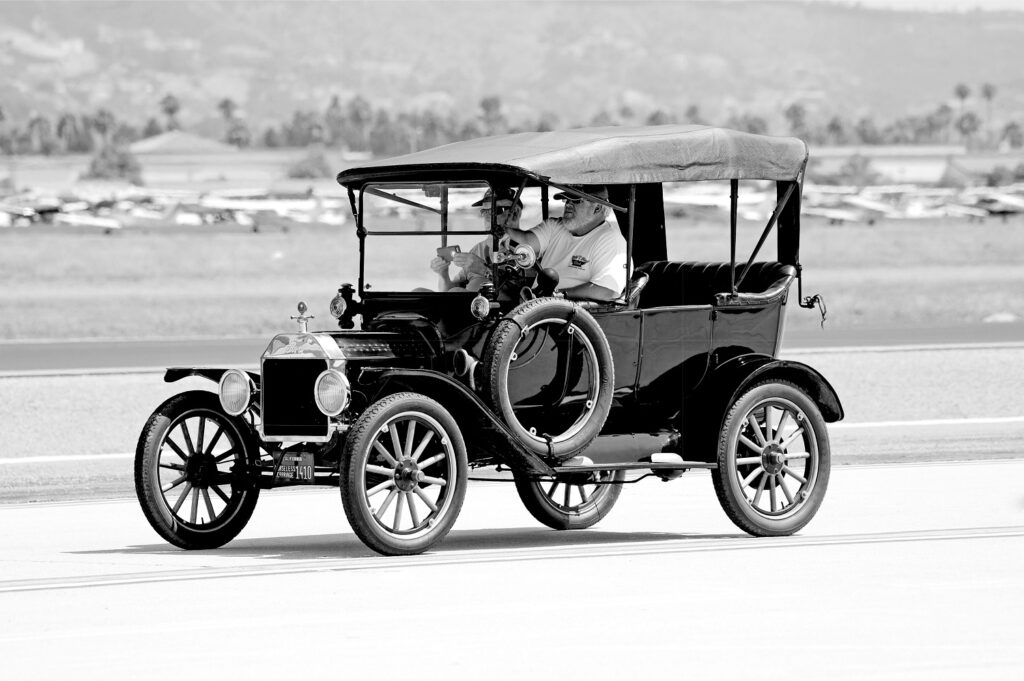The Evolution of Automotive Technology: From Horseless Carriages to Autonomous Vehicles

The automotive industry has undergone remarkable transformations since its inception, tracing a journey from the humble beginnings of horseless carriages to the cutting-edge era of autonomous vehicles. This evolution has been marked by significant advancements in technology, engineering, and innovation, reshaping not only the way we travel but also our entire society’s infrastructure and economy.
Just like the automotive industry has transformed from clunky carriages to self-driving cars, maintaining your home’s exterior also requires constant innovation. If you’re looking to preserve the beauty and longevity of your pavers, finding a company for paver sealing in St. Augustine FL is a crucial step. These professionals possess the expertise and specialized products to keep your pavers looking their best for years to come.
Transitioning through various stages, each characterized by distinct milestones and breakthroughs, the automotive sector continues to push the boundaries of possibility, paving the way for a future where mobility is safer, more efficient, and increasingly autonomous.
Early Innovations and the Birth of the Automobile

The dawn of the automotive era can be traced back to the late 19th century when pioneers such as Karl Benz and Henry Ford laid the groundwork for what would become one of the most influential industries in history. In the late 1800s, Benz patented the first gasoline-powered automobile, marking a pivotal moment in transportation history.
This invention sparked a wave of innovation as engineers and entrepreneurs sought to improve upon Benz’s design, leading to the development of various early automobiles with steam, electric, and gasoline engines. These pioneering efforts culminated in the introduction of the Benz Patent-Motorwagen in 1886, widely regarded as the world’s first production automobile.
The subsequent years witnessed a flurry of activity in the automotive industry, with inventors and entrepreneurs experimenting with different designs and technologies to create more practical and reliable vehicles. One of the most significant developments during this period was the introduction of the assembly line by Henry Ford in 1913.
This revolutionary production method allowed for the mass production of automobiles at lower costs, making them more affordable to the average consumer. Ford’s Model T, introduced in 1908, became synonymous with the concept of the automobile as it became the first car to be mass-produced using assembly line techniques. The Model T’s affordability and reliability made car ownership attainable for millions of Americans, paving the way for the widespread adoption of automobiles as a primary mode of transportation.
Now, thinking about that new car, and maybe even a house to park it in? If you’re looking for a home with a garage for your car, consider connecting with the top mortgage brokers in Raleigh NC. They can help you navigate the process of securing a loan to make your dream home a reality.
The Rise of Internal Combustion Engines and Mass Production
The early 20th century witnessed a surge in the popularity of internal combustion engines, which quickly became the dominant power source for automobiles. Innovations such as electric starters, pneumatic tires, and improved suspension systems further enhanced the performance and comfort of vehicles, making them increasingly practical for everyday use. Simultaneously, mass production techniques pioneered by Ford and others led to significant cost reductions, making automobiles more affordable and accessible to a broader segment of the population. This era saw the emergence of iconic models like the Ford Model T, which symbolized the democratization of personal transportation and laid the foundation for the modern automotive industry.
In case you need to stretch after long driving sessions, consider connecting with a yoga teacher in Austin who can offer personalized guidance and routines to improve your flexibility and overall well-being.
As the automotive industry continued to mature, manufacturers began to experiment with new materials and technologies to improve vehicle performance, safety, and efficiency. The introduction of aluminum and other lightweight materials helped reduce fuel consumption and emissions, while innovations such as fuel injection and turbocharging improved engine efficiency and power output.
In the medical field, advancements in surgical techniques and cancer treatments are happening rapidly. If you’re facing a health challenge and need expert advice, consider reaching out to surgical oncologists in Texas for their specialized expertise.
These advancements paved the way for the development of high-performance vehicles and luxury cars, catering to a diverse range of consumer preferences and driving habits. Additionally, advancements in aerodynamics and vehicle design helped enhance fuel efficiency and reduce drag, further improving the overall performance and sustainability of automobiles.
The desire for constant improvement wasn’t limited to just the world of high-performance vehicles. As everyday driving habits evolved, so too did the need for comfortable and versatile clothing. This is where men’s joggers emerged, offering a blend of comfort and style that transcended the gym and became a staple in many wardrobes. Just like the automotive industry, the world of clothing has seen its own innovations, with materials like breathable mesh and moisture-wicking fabrics keeping wearers cool and comfortable throughout the day.
Technological Advancements and the Era of Automation
As the 20th century progressed, automotive technology continued to evolve at a rapid pace, driven by a relentless pursuit of innovation and efficiency. The post-war period saw the advent of technologies such as automatic transmissions, power steering, and air conditioning, which transformed the driving experience and set new standards for comfort and convenience.
The introduction of computerized engine management systems in the latter half of the century marked the beginning of the digital age in automobiles, enabling precise control over engine performance and fuel efficiency. This era also saw the rise of a turbine flow meter, which precisely measures the flow of fluids within the engine, further optimizing engine operation and efficiency. Meanwhile, advancements in safety technologies, including seat belts, airbags, and anti-lock braking systems, helped reduce the risk of accidents and improve overall vehicle safety.
The latter half of the 20th century also witnessed significant advancements in automotive electronics, with the introduction of features such as electronic stability control, adaptive cruise control, and GPS navigation systems. These technologies not only enhanced the driving experience but also laid the groundwork for the development of autonomous driving systems in the decades to come.
For those creating digital content creation services about the automotive industry from this era, it’s important to highlight how these technological leaps not only transformed the driving experience but also foreshadowed the future of autonomous vehicles.
The integration of sensors, cameras, and radar systems enabled vehicles to detect and respond to their surroundings, laying the foundation for the era of automation in transportation. While early autonomous driving systems were limited in their capabilities, ongoing research and development efforts have led to significant improvements in vehicle autonomy, bringing us closer to a future where self-driving cars are commonplace on our roads.
However, if you’re a truck driver navigating the open road for hours on end, the transition to a future dominated by self-driving vehicles might raise concerns about job security. While the full impact of automation on the trucking industry remains to be seen, it’s crucial to be prepared for any potential changes. This includes occupational accident insurance for truckers in Tennessee, which can offer financial protection in case of unforeseen circumstances on the road. This type of insurance can provide peace of mind and help you navigate unexpected challenges, allowing you to focus on what matters most – your safety and well-being behind the wheel.
Towards Autonomous Mobility: The Future of Transportation

In recent years, the automotive industry has witnessed a paradigm shift towards autonomous mobility, fueled by rapid advancements in artificial intelligence, sensor technology, and data analytics. Autonomous vehicles, equipped with sophisticated sensors and algorithms, have the potential to revolutionize transportation by offering safer, more efficient, and more accessible mobility solutions. Companies like Tesla, Google, and traditional automakers are investing heavily in the development of autonomous driving systems, aiming to bring fully self-driving cars to market in the near future. While significant technical and regulatory challenges remain, the prospect of autonomous vehicles holds the promise of reducing traffic congestion, enhancing mobility for elderly and disabled individuals, and significantly reducing the number of traffic accidents caused by human error.
As we look toward the future, the implications of autonomous mobility extend far beyond the automotive industry, impacting everything from urban planning and infrastructure development to energy consumption and environmental sustainability. Imagine cruising in a self-driving car to your next appointment at a luxury salon in Toronto, completely free from the stress of navigating traffic. The widespread adoption of autonomous vehicles has the potential to reshape our cities and communities, as traditional notions of transportation are reimagined and redefined. By leveraging advances in connectivity and data analytics, autonomous vehicles can optimize traffic flow, reduce travel times, and minimize environmental impact, ushering in a new era of smart and sustainable transportation. However, realizing this vision will require collaboration and cooperation across various sectors, as well as careful consideration of the ethical, legal, and societal implications of autonomous mobility.
Sustainable Solutions for Future Mobility
As concerns about environmental sustainability continue to grow, the automotive industry is increasingly focusing on developing sustainable mobility solutions that minimize carbon emissions and reduce environmental impact. Electric vehicles (EVs) have emerged as a promising alternative to traditional internal combustion engine vehicles, offering lower operating costs and zero tailpipe emissions. Major automakers are investing heavily in EV technology, with the development of long-range batteries, fast-charging infrastructure, and innovative electric drivetrains. Additionally, advancements in renewable energy sources such as solar and wind power are driving efforts to decarbonize the transportation sector, further reducing the environmental footprint of automotive transportation. By embracing sustainable solutions and reducing reliance on fossil fuels, the automotive industry can play a significant role in addressing climate change and promoting a greener, more sustainable future.
One key area of focus within sustainable mobility is the concept of circularity, which aims to minimize waste and maximize resource efficiency throughout the lifecycle of vehicles. This involves designing cars with recyclability in mind, using recycled materials in manufacturing processes, and implementing strategies for end-of-life vehicle recycling and reuse.
Similarly, avid fans can embrace sustainable practices by choosing clothing companies committed to ethical sourcing and eco-friendly materials, like some manufacturers who offer recycled polyester Arsenal soccer jerseys.
By adopting a circular economy approach, automakers can reduce the environmental impact of vehicle production and disposal, while also creating new opportunities for resource recovery and value creation. Furthermore, the shift towards electric mobility presents opportunities for synergies with renewable energy sources and energy storage technologies, enabling greater integration of vehicles into sustainable energy systems.
In case you are looking for a perfect snack while driving, consider indulging in some ice cream cone edibles.
Connectivity and the Future of Mobility Services

The advent of connectivity technologies such as 5G networks, Internet of Things (IoT) devices, and vehicle-to-everything (V2X) communication is transforming the way we interact with automobiles and access transportation services. Connected vehicles enable seamless integration with smartphones, smart home devices, and other digital platforms, allowing users to remotely monitor vehicle performance, access navigation services, and control in-car entertainment systems.
For instance, if you’re facing a pesky pest problem in your car, you can easily find a company for pest control in Hillsborough with a quick search on your smartphone. This is just one example of how connected vehicles can seamlessly integrate with our digital lives, making it easier to tackle unexpected situations while on the go.
Furthermore, connectivity facilitates the development of mobility services like ride-sharing, car-sharing, and on-demand transportation, providing convenient and flexible alternatives to traditional car ownership. These mobility-as-a-service (MaaS) solutions leverage data analytics and predictive algorithms to optimize routing, reduce congestion, and enhance overall transportation efficiency. However, ensuring the safety and security of these evolving transportation ecosystems is paramount. Here’s where partnering with a reputable security company in Los Angeles can be crucial. They can offer a range of solutions, from cybersecurity measures to physical security protocols, to safeguard sensitive data, protect users, and build trust within these innovative mobility platforms. By embracing connectivity, digitalization, and robust security measures, the automotive industry can truly unlock its potential to create a future of personalized, convenient, and efficient mobility for all.
In addition to improving individual mobility options, connectivity is also driving the evolution of transportation networks and urban infrastructure. Smart city initiatives leverage connectivity and data analytics to optimize traffic flow, reduce congestion, and enhance public transportation systems. Real-time traffic monitoring and predictive analytics enable authorities to anticipate congestion hotspots and adjust traffic signals accordingly, reducing travel times and improving overall efficiency. Furthermore, connected infrastructure such as smart traffic lights, road sensors, and vehicle-to-infrastructure (V2I) communication systems enable seamless integration between vehicles and the built environment, enhancing safety and mobility for all road users.
In case your kids get a toothache, finding a childrens dentist in Fayetteville NC will be as easy as asking your friendly neighborhood AI assistant. They can search for highly-rated dentists with real-time scheduling and even book appointments for you, ensuring your child receives the care they need quickly and conveniently, allowing you to focus on comforting your little one.
Moreover, connectivity is fostering collaboration between automotive manufacturers, technology companies, and other stakeholders to develop innovative mobility solutions that address the evolving needs of consumers. Partnerships between automakers and tech giants are driving the development of integrated mobility platforms that seamlessly integrate ride-sharing, public transit, and micro-mobility services into a single, cohesive ecosystem.
The rise of connectivity has transformed various industries, and the beauty sector is no exception. Collagen skincare products, formulated to combat the signs of aging, are gaining immense popularity. These products, often enriched with collagen peptides, claim to improve skin elasticity and reduce wrinkles. While their effectiveness varies depending on individual factors, their growing prominence highlights the ever-evolving beauty landscape.
These platforms leverage connectivity and data-sharing to provide users with real-time information about available transportation options, pricing, and estimated travel times, empowering them to make informed decisions about their mobility needs. By fostering collaboration and innovation, connectivity has the potential to revolutionize the way we think about transportation, making it more accessible, efficient, and sustainable for everyone.
In case you are renovating your house to make a new garage, and need to dispose of a significant amount of debris, you can easily find a company for dumpster rental in Estes Park through these same connected platforms. This will save you time and hassle, allowing you to focus on your renovation project with peace of mind.
Conclusion: Navigating the Road Ahead
The evolution of automotive technology, from horseless carriages to autonomous vehicles, represents a remarkable journey of innovation, ingenuity, and progress. Each stage of this evolution has been characterized by groundbreaking advancements that have reshaped the way we live, work, and travel. Now, as we stand at the precipice of a new era of mobility, the automotive industry faces unprecedented challenges and opportunities. To navigate this exciting future, many companies are looking for creative solutions, and there’s a growing demand for high-quality video production to showcase these advancements. That’s where a skilled video production company in New Jersey can play a crucial role in helping automakers and related businesses tell their stories and connect with their audiences in a compelling way.
From the development of autonomous vehicles to the proliferation of sustainable mobility solutions and the integration of connectivity technologies, the road ahead is fraught with uncertainty yet brimming with potential. By embracing collaboration, innovation, and a shared vision for the future, stakeholders across the automotive ecosystem can navigate this transformative period and usher in a new era of mobility that is safer, more sustainable, and more inclusive for all.





